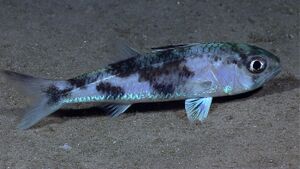Biology:Acropomatidae
| Acropomatidae | |
|---|---|

| |
| Synagrops bellus | |
| Scientific classification | |
| Domain: | Eukaryota |
| Kingdom: | Animalia |
| Phylum: | Chordata |
| Class: | Actinopterygii |
| Order: | Perciformes |
| Superfamily: | Percoidea |
| Family: | Acropomatidae T. N. Gill, 1893[2] |
| Genera | |
|
See text | |
Acropomatidae is a family of fish in the order Perciformes, commonly known as lanternbellies. Acropoma species are notable for having light-emitting organs along their undersides. They are found in all temperate and tropical oceans, usually at depths of several hundred meters.[3] There are about 32 species in as many as 9 genera, although some authorities recognise fewer genera than Fishbase does.
Members of the family are generally small, with some ranging up to 40 cm, but most no more than 15 cm. They have two dorsal fins, the first with seven to 10 spines and the second with possibly a spine in addition to eight to 10 soft rays. The anal fin has two or three spines, and the pelvic fins one spine and five soft rays.
Timeline of genera
<timeline> ImageSize = width:1000px height:auto barincrement:15px PlotArea = left:10px bottom:50px top:10px right:10px
Period = from:-65.5 till:10 TimeAxis = orientation:horizontal ScaleMajor = unit:year increment:5 start:-65.5 ScaleMinor = unit:year increment:1 start:-65.5 TimeAxis = orientation:hor AlignBars = justify
Colors =
#legends id:CAR value:claret id:ANK value:rgb(0.4,0.3,0.196) id:HER value:teal id:HAD value:green id:OMN value:blue id:black value:black id:white value:white id:cenozoic value:rgb(0.54,0.54,0.258) id:paleogene value:rgb(0.99,0.6,0.32) id:paleocene value:rgb(0.99,0.65,0.37) id:eocene value:rgb(0.99,0.71,0.42) id:oligocene value:rgb(0.99,0.75,0.48) id:neogene value:rgb(0.999999,0.9,0.1) id:miocene value:rgb(0.999999,0.999999,0) id:pliocene value:rgb(0.97,0.98,0.68) id:quaternary value:rgb(0.98,0.98,0.5) id:pleistocene value:rgb(0.999999,0.95,0.68) id:holocene value:rgb(0.999,0.95,0.88)
BarData=
bar:eratop bar:space bar:periodtop bar:space bar:NAM1 bar:NAM2 bar:NAM3 bar:NAM4
bar:space bar:period bar:space bar:era
PlotData=
align:center textcolor:black fontsize:M mark:(line,black) width:25 shift:(7,-4) bar:periodtop from: -65.5 till: -55.8 color:paleocene text:Paleocene from: -55.8 till: -33.9 color:eocene text:Eocene from: -33.9 till: -23.03 color:oligocene text:Oligocene from: -23.03 till: -5.332 color:miocene text:Miocene from: -5.332 till: -2.588 color:pliocene text:Plio. from: -2.588 till: -0.0117 color:pleistocene text:Pleist. from: -0.0117 till: 0 color:holocene text:H.
bar:eratop from: -65.5 till: -23.03 color:paleogene text:Paleogene from: -23.03 till: -2.588 color:neogene text:Neogene from: -2.588 till: 0 color:quaternary text:Q.
PlotData=
align:left fontsize:M mark:(line,white) width:5 anchor:till align:left
color:eocene bar:NAM1 from: -55.8 till: 0 text: Acropoma color:eocene bar:NAM2 from: -55.8 till: 0 text: Verilus color:eocene bar:NAM3 from: -37.2 till: 0 text: Synagrops
PlotData=
align:center textcolor:black fontsize:M mark:(line,black) width:25
bar:period from: -65.5 till: -55.8 color:paleocene text:Paleocene from: -55.8 till: -33.9 color:eocene text:Eocene from: -33.9 till: -23.03 color:oligocene text:Oligocene from: -23.03 till: -5.332 color:miocene text:Miocene from: -5.332 till: -2.588 color:pliocene text:Plio. from: -2.588 till: -0.0117 color:pleistocene text:Pleist. from: -0.0117 till: 0 color:holocene text:H.
bar:era from: -65.5 till: -23.03 color:paleogene text:Paleogene from: -23.03 till: -2.588 color:neogene text:Neogene from: -2.588 till: 0 color:quaternary text:Q.
</timeline>
Genera
The following nine genera are currently placed within the family Acropomatidae:[3][4]
- Acropoma Temminck & Schlegel, 1843
- Apogonops Ogilby, 1896
- Caraibops Schwarzhans & Prokofiev, 2017
- Doederleinia Steindachner, 1883
- Kaperangus Schwarzhans & Prokofiev, 2017
- Malakichthys Döderlein, 1883
- Neoscombrops Gilchrist, 1922
- Parascombrops Alcock, 1889
- Synagrops Günther, 1887
- Verilus Poey, 1860
The 5th edition of Fishes of the World lists seven valid genera[5] while the Catalog of Fishes only recognises five.[6]
Taxonomy
The Acriopomatidae is placed in the order Perciformes, the suborder Percoidei and the superfamily Percoidea in the 5th edition of Fishes of the World.[5] However, during the 21st Century molecular studies have indicated that a variety of mainly deep-sea fishes which were traditionally placed in the Perciformes, including the Acropomatidae, and in the Trachiniformes in fact from a newly recognised clade which has been named either the Acropomatiformes or Pempheriformes.[7] Within the Acropomatidae phylogenetic work has suggested that the genera Acropoma and Doederleinia are separate from the other genera in the traditional arrangement of the family with two other recognised lineages being placed in the separate families Malakichthyidae and Synagropidae.[8]
This classification would be as follows:[9][10][11]
- Acropmatidae
- Acropoma
- Doederleinia
- Malakichthyidae
- Apogonops
- Neoscombrops
- Malakichthys
- Verilus
- Synagropidae
- Caraibops
- Kaperangus
- Parascombrops
- Synagrops
References
- ↑ Sepkoski, J.J.Jr (2002): A Compendium of Fossil Marine Animal Genera. Bulletins of American Paleontology, 363: 1-560.
- ↑ Richard van der Laan; William N. Eschmeyer; Ronald Fricke (2014). "Family-group names of Recent fishes". Zootaxa 3882 (2): 001–230. https://biotaxa.org/Zootaxa/article/view/zootaxa.3882.1.1/10480.
- ↑ 3.0 3.1 Froese, Rainer, and Daniel Pauly, eds. (2019). "Acropomatidae" in FishBase. December 2019 version.
- ↑ Yamanoue, Y. (2016): Revision of the genus Verilus (Perciformes: Acropomatidae) with a description of a new species. Journal of Fish Biology, 89 (5): 2375–2398.
- ↑ 5.0 5.1 J. S. Nelson; T. C. Grande; M. V. H. Wilson (2016). Fishes of the World (5th ed.). Wiley. pp. 434. ISBN 978-1-118-34233-6. https://sites.google.com/site/fotw5th/. Retrieved 2020-02-27.
- ↑ Eschmeyer, William N.; Fricke, Ron; van der Laan, Richard, eds. "Genera in the family Acropomatidae". California Academy of Sciences. http://researcharchive.calacademy.org/research/ichthyology/catalog/fishcatget.asp?tbl=genus&family=Acropomatidae.
- ↑ "Phylogeny of Enigmatic Acropomatiform Fishes with a Preliminary Assessment of Morphological Support". Kansas State University. 2018. https://cpb-us-e1.wpmucdn.com/conferences.k-state.edu/dist/1/33/files/2018/05/Abstracts-Sacerdote-Velat-Zobek-2n87u6z.pdf.
- ↑ Ghedotti MJ; Gruber JN; Barton RW; Davis MP; Smith WL (2018). "Morphology and evolution of bioluminescent organs in the glowbellies (Percomorpha: Acropomatidae) with comments on the taxonomy and phylogeny of Acropomatiformes". Journal of Morphology 279 (11): 1640–1653. doi:10.1002/jmor.20894. Abstract
- ↑ Eschmeyer, William N.; Fricke, Ron; van der Laan, Richard, eds. "Genera in the family Acropmatidae". California Academy of Sciences. http://researcharchive.calacademy.org/research/ichthyology/catalog/fishcatget.asp?tbl=genus&family=Acropmatidae.
- ↑ Eschmeyer, William N.; Fricke, Ron; van der Laan, Richard, eds. "Genera in the family Malakichthyidae". California Academy of Sciences. http://researcharchive.calacademy.org/research/ichthyology/catalog/fishcatget.asp?tbl=genus&family=Malakichthyidae.
- ↑ Eschmeyer, William N.; Fricke, Ron; van der Laan, Richard, eds. "Genera in the family Synagropidae". California Academy of Sciences. http://researcharchive.calacademy.org/research/ichthyology/catalog/fishcatget.asp?tbl=genus&family=Synagropidae.
Wikidata ☰ Q280743 entry
 |

